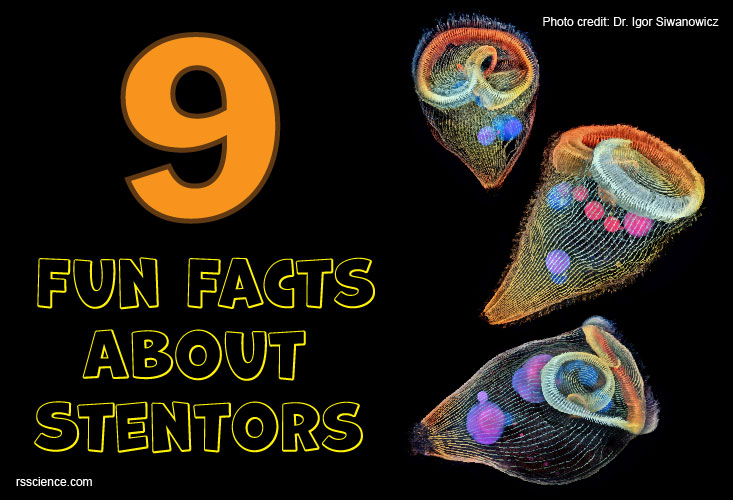This article covers
1. Stentors are the trumpeter of the microscopic symphony orchestra
Stentor is sometimes referred to as a trumpet animalcule because it can take on the shape of a trumpet. However, these trumpeters are shy and sensitive. When they sense suspicious activities, they can quickly contract by hiding their trumpets (or the “crown” of cilia) inside the body and run away.

[In this image] Anatomy of a Stentor coeruleus cell: (left) fully extended form; (right) contracted form.
Photo credit: Current Biology
2. Stentors are the blue whale of the microscopic world
Stentors are relatively easy to find in pond water as they are one of the largest unicellular microorganisms. Some Stentors can reach a size of up to 4 mm (4,000 micrometers) when stretched out. Comparing to a bacterium (1 micrometer in length), Stentors are literately the blue whales of the microscopic world.

[In this image] A size chart showing the relative size comparison between animals.
Note that although the Rotifer is a multicellular organism, it is smaller than the single-celled Stentor.
Another common feature shared by Stentors and blue whales is that both of them are filter-feeders. A blue whale can eat up to four tones of krill (tiny shrimp-like animals) every day through its baleen plates. Similarly, Stentors collect bacteria, algae, and other small microorganisms by their cilia.
3. Stentors are the most colorful microorganisms
Many microorganisms are almost transparent. However, Stentor can be very colorful – there are green, blue, yellow, and amethyst-colored species. Stentor coeruleus is a famous example and it appears blue-green-ish due to the presence of stentorin, a natural pigment. Stentorin can help S. coeruleus respond to visible light stimuli. These pigments are stored in pigment granules which align into many stripes under the skin (cortex) of the Stentors.
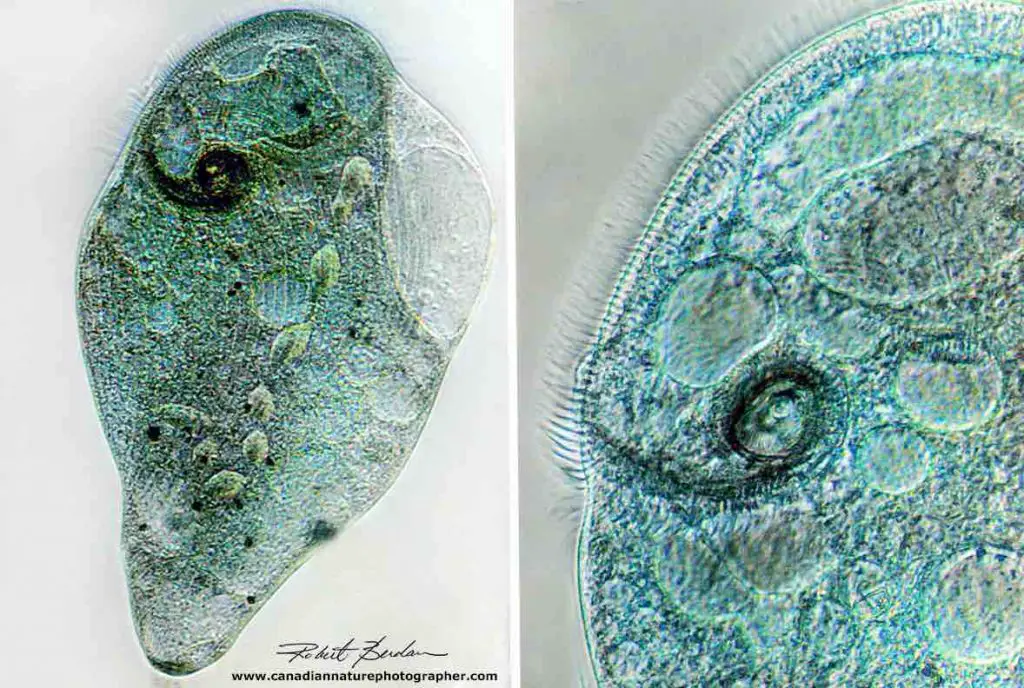
[In this image] Stentor coeruleus.
Photo credit: The Canadian Nature Photographer
Some Stentor species, such as Stentor polymorphus, show a green color as a result of the microscopic green algae that Stentor ingests. These green algae live within the Stentors in a relationship of symbiosis, meaning the algae and Stentors mutually benefit from the close association. Stentors provide a safe place for green algae. In return, green algae use photosynthesis to convert Stentor’s waste products to useful nutrients.
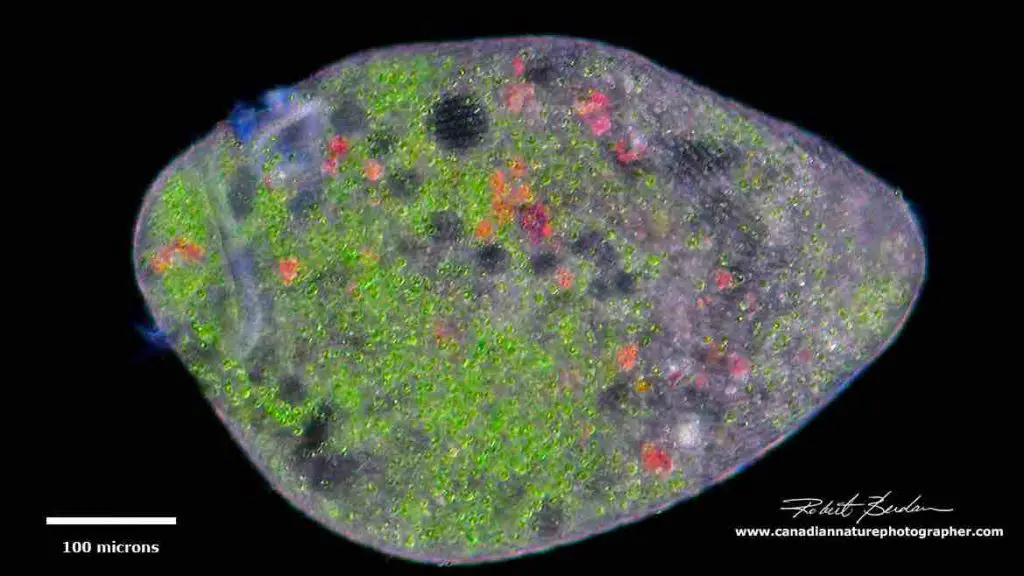
[In this image] Stentor polymorphus viewed by Darkfield microscopy showing endosymbionts – algae living inside.
Photo credit: The Canadian Nature Photographer
4. Although a Stentor is a single cell, it has all the vital “organs” of the body
Stentor is a single-celled organism, meaning one Stentor consists of only one giant cell. However, this does not mean the Stentor cell is simple. In fact, there are several unique cellular structures, which function like our organs to keep the cell alive. For example, Stentor collects its food by cilia (similar to our hands) into its cytostome (mouth). The food particles travel down to a tube-like gullet (esophagus) and are enclosed into food vacuoles (like our stomach) for digestion. After the nutrition from the food is extracted, this vacuole moves to the outer cell wall and “pops”, evacuating the remaining debris.
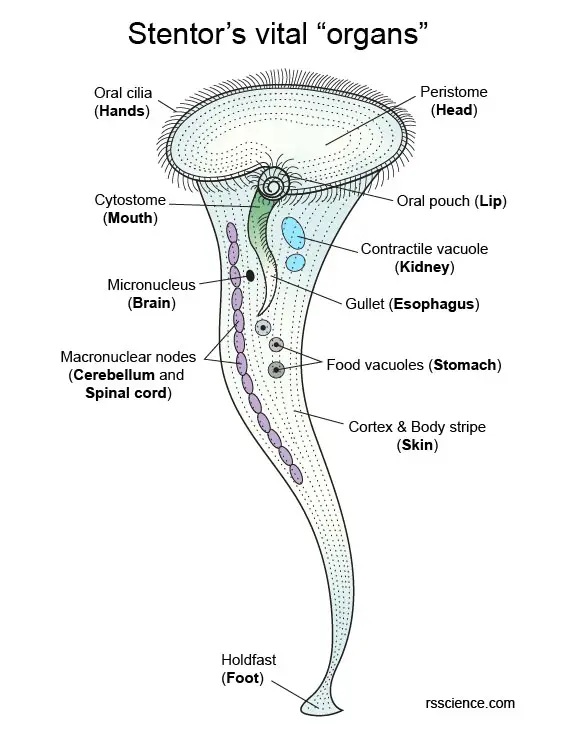
[In this image] The analogy of Stentor’s organelles and their cellular function to human’s vital organs.
Click here to learn all the functions of Stentor’s cell organelles.
5. Some Stentors arrange their nuclei into a string of pearls
Stentors have two kinds of nuclei in a cell. Each Stentor has one small, rounded micronucleus which carries its genetic materials. At the same time, it can have one or many macronuclei which are significantly larger than the micronucleus. The macronucleus is responsible for all animal’s metabolic activities. The shape of the macronucleus can vary. It can be a single ball, vermiform, nodular, or moniliform (like a string of pearls).
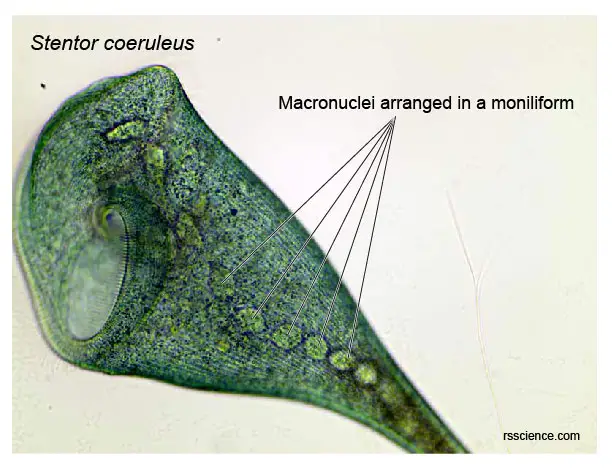
[In this image] Several macronuclei in a Stentor coeruleus form a string of pearls (called moniliform). Modified from Wikimedia.
Photo credit: Modified from Wikimedia
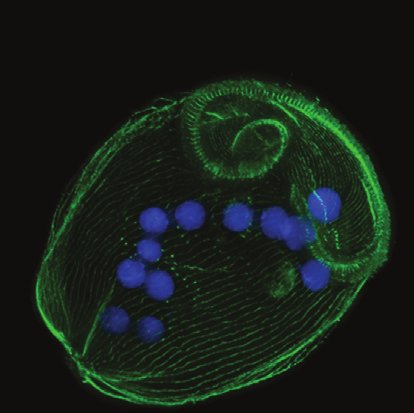
[In this image] A Stentor under a fluorescence microscope.
The macronucleus is stained by blue. Cilia and body stripes are stained with green.
Photo credit: ResearchGate
6. Stentor was named after a Trojan War hero
The name “Stentor” came from Greek mythology. Stentor was a herald of the Greek forces during the Trojan War. He is mentioned briefly in Homer’s Iliad in which he had a voice as powerful as fifty voices of other men. His voice encouraged the Greeks to fight.
7. Stentors “surprisingly” use the standard genetic codes
In a DNA molecule, there are four bases of DNA – the A, C, G, and T. Every three nucleotides in a row count as a triplet and code for a single amino acid. Many codons contain instructions to manufacture proteins, which are chains of amino acids.
Most organisms on earth use the standard genetic code, which we use, too. However, many ciliates commonly use non-standard code. Since Stentors are iconic members of the ciliate family; however, scientists “surprisingly” found that Stentors resisted that trend and only use standard genetic code. The reason is still a mystery.
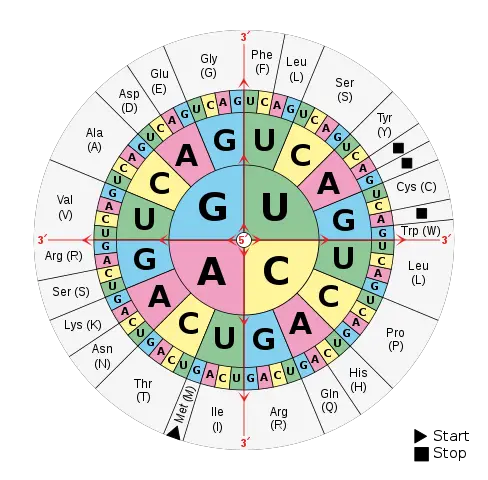
[In this image] The standard RNA codon table organized in a wheel.
Photo credit: Wiki
8. Stentors have an amazing ability to regenerate
You may know that some organisms, such as lizards, planarians, and sea stars, can regenerate missed body parts. These examples are all multicellular organisms that can regenerate their missing part by cell divisions. Can a single-cellular microorganism regenerate? Stentors say “YES”!
Stentor is known for its amazing ability to regenerate. If a Stentor’s cell is cut into small pieces, each fragment can grow into an entire Stentor. According to different studies, a Stentor can be minced into anywhere from 64 to 100 segments!
[In this video] UCSF scientists are studying these giant single-celled organisms that regenerate to get insight into how human cells could recover from injury.
In order to regenerate a new Stentor, the fragment must contain a portion of the macronucleus and the cell membrane. For Stentors, this requirement is not that difficult to meet. Each Stenter can have many macronuclei located dispersedly in the cell and the cell membrane covers the entire cell.
Stentor’s macronucleus is polyploidy. The term “ploidy” means the number of sets of chromosomes in a cell. Human cells are diploid because they have two sets. The Stentor macronucleus contains so many copies of chromosomes (tens of thousands or higher, various by species) that it’s highly likely that a small piece will contain the necessary genetic information to create a new individual.
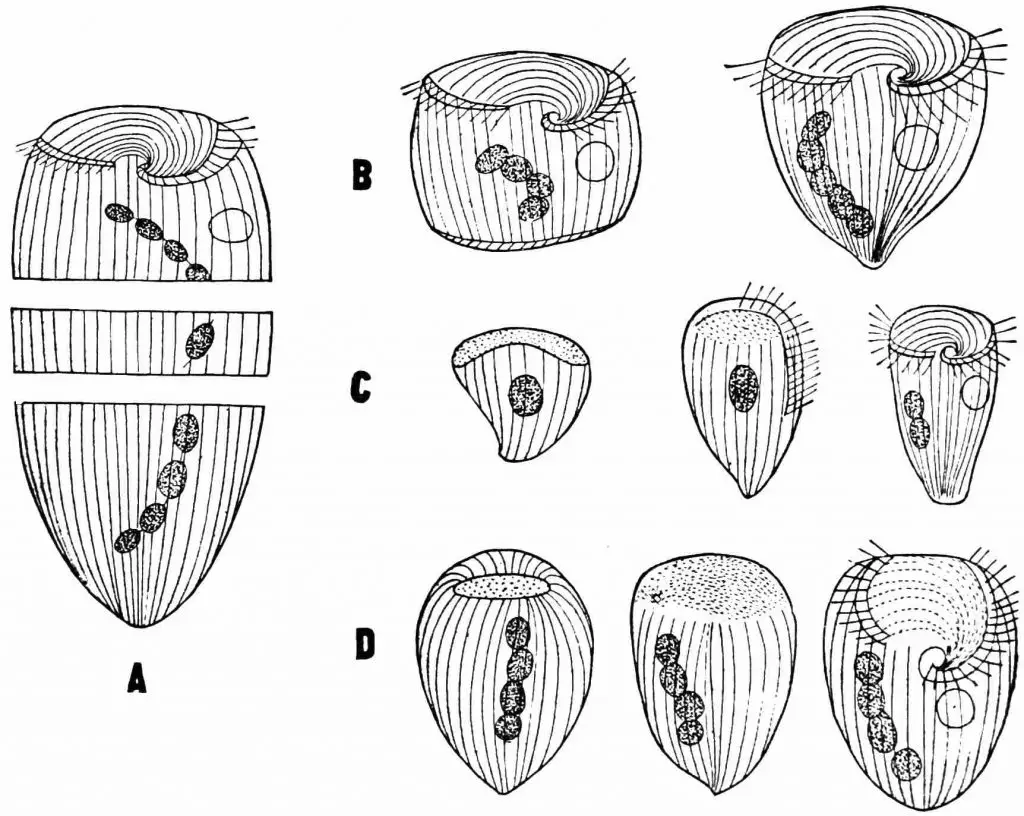
[In this image] Almost any piece of the Stentor can regenerate as long as it contains part of the macronucleus and a small portion of the original cell membrane/cortex.
Photo credit: Wiki
9. Can a single cell “change its mind”? Stentor can
Stentor consists of just one cell, so many people likely have the impression that its behavior must be very simple. However, a recent study confirmed that at least one species of Stentor can change its behavior based on the circumstances.
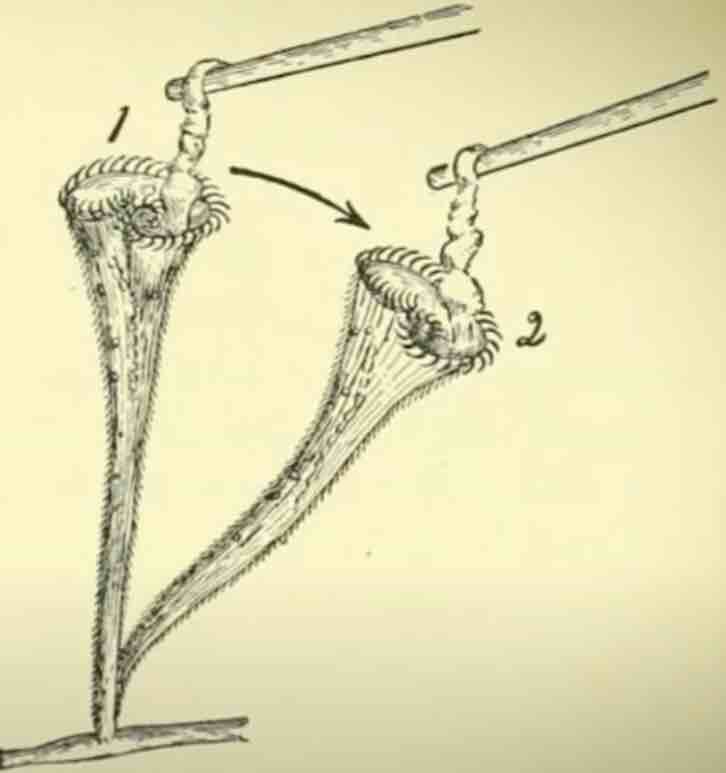
[In this image] The illumination by Herbert Spencer Jennings to show the study of Stentor’s behaviors.
In 1906, a scientist named Herbert Spencer Jennings reported Stentor roeselii can change its response to a stimulus. To do so, Jennings added carmine powder to the water hosting these Stentors. Carmine is a red dye that is irritant toward Stentors. Jennings noticed that at first Stentor bent its body to avoid the Carmine powder. If the powder kept on appearing, the Stentor reversed the direction of its cilia movement to push the powder away from its body. If this action didn’t work, the Stentor changed its strategy and contracted its body. If this behavior still failed to protect it from the irritant, the Stentor detached its body from the substrate and swum away. This series of actions seems to suggest the single-cellular Stentor can “change its mind”!
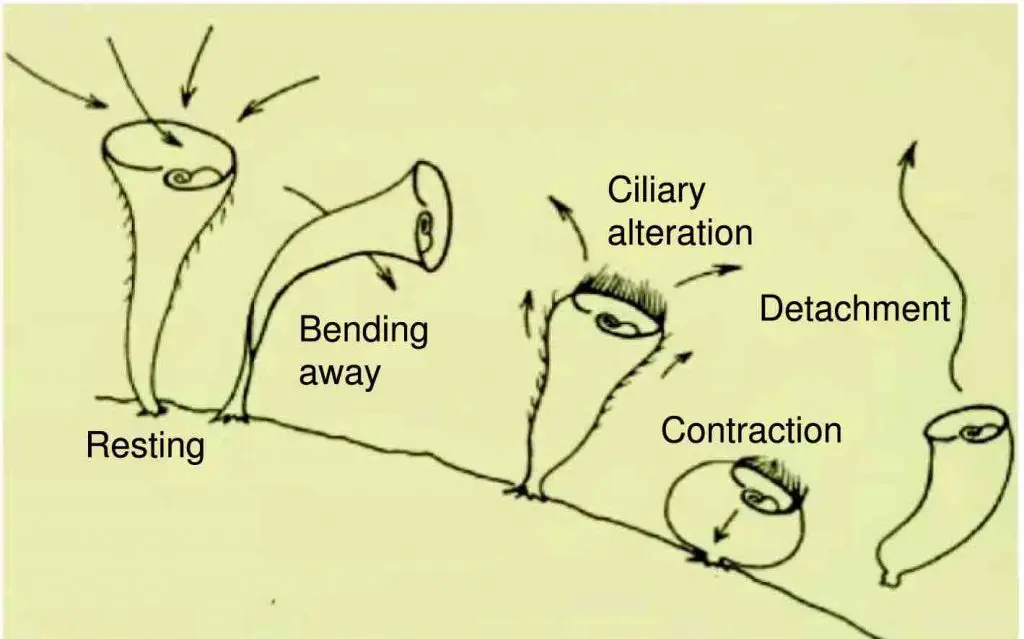
[In this image] A hierarchy of avoidance behaviors by Stentor roeseli.
Photo credit: Dexter JP., et. al., 2019, Current Biology
This interesting result attracted the attention of other scientists. In 1967, a group of scientists attempted to repeat Jennings’ experiment, but failed. Unfortunately, Jennings’ work was discredited and ignored. Recently, Jeremy Gunawardena from Harvard became interested in this experiment. He found that the 1967 experiment had used Stentor coeruleus, not Stentor roeselii, because the researchers couldn’t find the latter species. The two species have slightly different behavior.
In this new study, Jeremy used microplastic beads as the irritant. He was able to replicate all of Jennings’ observations and also made some new discoveries. Jeremy found Stentor roeselii has a sequence of behaviors to deal with these circumstances. The results suggested that these single-celled animals are capable of simple forms of learning – the fact that they can do so in the absence of a nervous system is fascinating.
[In this video] Can a single cell be sophisticated enough to “change its mind”?
References
“Self-repairing cells: How single cells heal membrane ruptures and restore lost structures”
“A Complex Hierarchy of Avoidance Behaviors in a Single-Cell Eukaryote”
“Stentor coeruleus”

